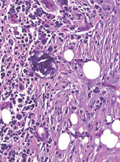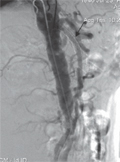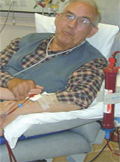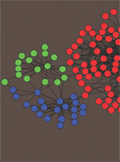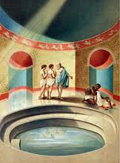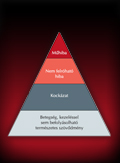The eLitMed.hu medical portal uses computer cookies for convenient operation. Detailed information can be found in the Cookie-policy.
Lege Artis Medicinae - 2012;22(06-07)
Content
[Efficiency and safety of biphasic aspart insulin therapy in clinical studies]
[Six-to-eight years after the diagnosis of type 2 diabetes the majority of patients require insulin treatment. Premixed insulin therapy provides an insulin profile that is closer to the physiological profile than that achieved by basal insulin supplementation and, in some cases, may serve as an alternative treatment in patients for whom intensified insulin therapy is unsuitable. However, if premixed human insulins are used, nocturnal hypoglycaemia occurs relatively frequently. Furthermore, patients must keep a lag-time of 30-45 minutes between the injection of insulin and eating. In contrast, if premixed insulin analogues are used, there is no need for such lag-time and both nocturnal and severe hypoglycaemia are less frequent than with human premixed therapy. The superiority of premixed insulin analogues compared with premixed human insulin therapy has been confirmed by a number of prospective, randomised controlled trials and retrospective analyses. The author summarises the results of these studies, emphasising the beneficial effects of premixed insulin analogues in the therapy of type 2 diabetes.]
[Idiopathic retroperitoneal fibrosis (Morbus Ormond) associated with severe cardiomyopathy in a young man: a case report]
[INTRODUCTION - The cause of idiopathic retroperitoneal fibrosis is unknown, but probably involves a chronic, nonspecific, autoimmune inflammation. This rare disease mostly affects middle-aged or elderly people, it hardly ever occurs in young people. It causes obstruction of the urinary tract, postrenal insufficiency as well as functional disorder of vital organs in the retroperitoneum and its surrounding area. The diagnosis is based on diagnostic imaging and histological examinations. Surgical treatment of the urinary obstruction is only efficient in the long-term if combined with immunomodulatory treatment. CASE REPORT - A young, 34-year-old man who presented with oedema in his legs was diagnosed with retroperitoneal fibrosis. Autoimmune serology was negative. He needed temporary nephrostomy on the right side. Treatment with steroid and colchicine was initially successful. His severe cardiomyopathy improved gradually. No regression occurred with tamoxifen, so we started to administer azathioprine with methylprednisolone. The control abdominal CT showed stagnation of the process. CONCLUSIONS - Because of the rarity of this disease, no randomised controlled trials are available regarding its treatment. The aim of treatment is to eradicate the symptoms, solve the urinary obstruction, maintain renal function and prevent progression of the disease. Improvement may be achieved by corticosteroids, cyclophosphamide, azathioprine, leflunomide, mycophenolate mofetil and tamoxifen. To our knowledge, this case is unique as no similar case with severe cardiomyopathy and idiopathic retroperitoneal fibrosis has been reported in the literature previously.]
[Use of a drug-eluting stent for the treatment of in-stent restenosis of the superior mesenteric artery]
[INTRODUCTION - Diagnosis and treating intestinal ischaemia in time presents a great challenge for clinicians. CASE REPORT - In a 60-year-old woman on dialysis who presented with abdominal angina, angiography revealed stenosis of the superior mesenteric artery, which was treated by implantation of a 6×29 mm Genesis stent. After a year, her symptoms reoccurred and angiography revealed restenosis, which was treated with a 7×34 mm Wallstent, while her previous acetylsalicylic acid treatment was supplemented with clopidrogel. Nevertheless, her abdominal angina reoccurred again after a year. During the next intervention - because of the in-stent restenosis - a Taxus Liberte stent was implanted. During the dual antiplatelet therapy, her abdominal complaints did not reoccur, her body weight increased and angiography did not reveal restenosis in the affected artery even after 4 years. CONCLUSIONS - A drug-eluting stent can be a good choice in case of restenosis of the superior mesenteric artery. In a stented patient, it is crucial to use an appropriately controlled, long-term, dual antiplatelet therapy.]
[Some psychological and system-oriented perspectives of modern eating disorders]
[The newer types of eating disorders are less common in the therapeutic practice or they may appear as a secondary disorder. Therefore only a little we know about the psychological background of these disorders. There is only a few data in the literature about the relational of family characteristics of muscle dysmorphia, eating disorder bodybuilder type, Adonis complex or orthorexia nervosa. As the classical eating disorders, like anorexia and bulimia nervosa are in a strong relationship with the newer types of eating disorders, we can assume several family factors on the basis of the underlying common features. The problems of self-esteem, the self-developmental disorder, the perfectionism, the need for control, and the relationship to the obsessionality and compulsivity are common characteristics of these disorders.]
[Network analysis in medicine]
[Network analysis is an increasingly used research method in medicine. Network analysis is a research and interpretation model at the same time. Our article outlines the various applications of network research in medicine and at its interdisciplinary boundaries. ]
1.
Clinical Neuroscience
Is there any difference in mortality rates of atrial fibrillation detected before or after ischemic stroke?2.
Clinical Neuroscience
Factors influencing the level of stigma in Parkinson’s disease in western Turkey3.
Clinical Neuroscience
Neuropathic pain and mood disorders in earthquake survivors with peripheral nerve injuries4.
Journal of Nursing Theory and Practice
[Correlations of Sarcopenia, Frailty, Falls and Social Isolation – A Literature Review in the Light of Swedish Statistics]5.
Clinical Neuroscience
[Comparison of pain intensity measurements among patients with low-back pain]1.
Clinical Neuroscience Proceedings
[A Magyar Stroke Társaság XVIII. Kongresszusa és a Magyar Neuroszonológiai Társaság XV. Konferenciája. Absztraktfüzet]2.
3.
Journal of Nursing Theory and Practice
[A selection of the entries submitted to the literary contest "Honorable mission: the joys and challenges of our profession" ]4.
Journal of Nursing Theory and Practice
[End of Life and Palliative Care of Newborns in the Nursing Context]5.
Journal of Nursing Theory and Practice
[Aspects of Occupational Health Nursing for Incurable Patients ]




